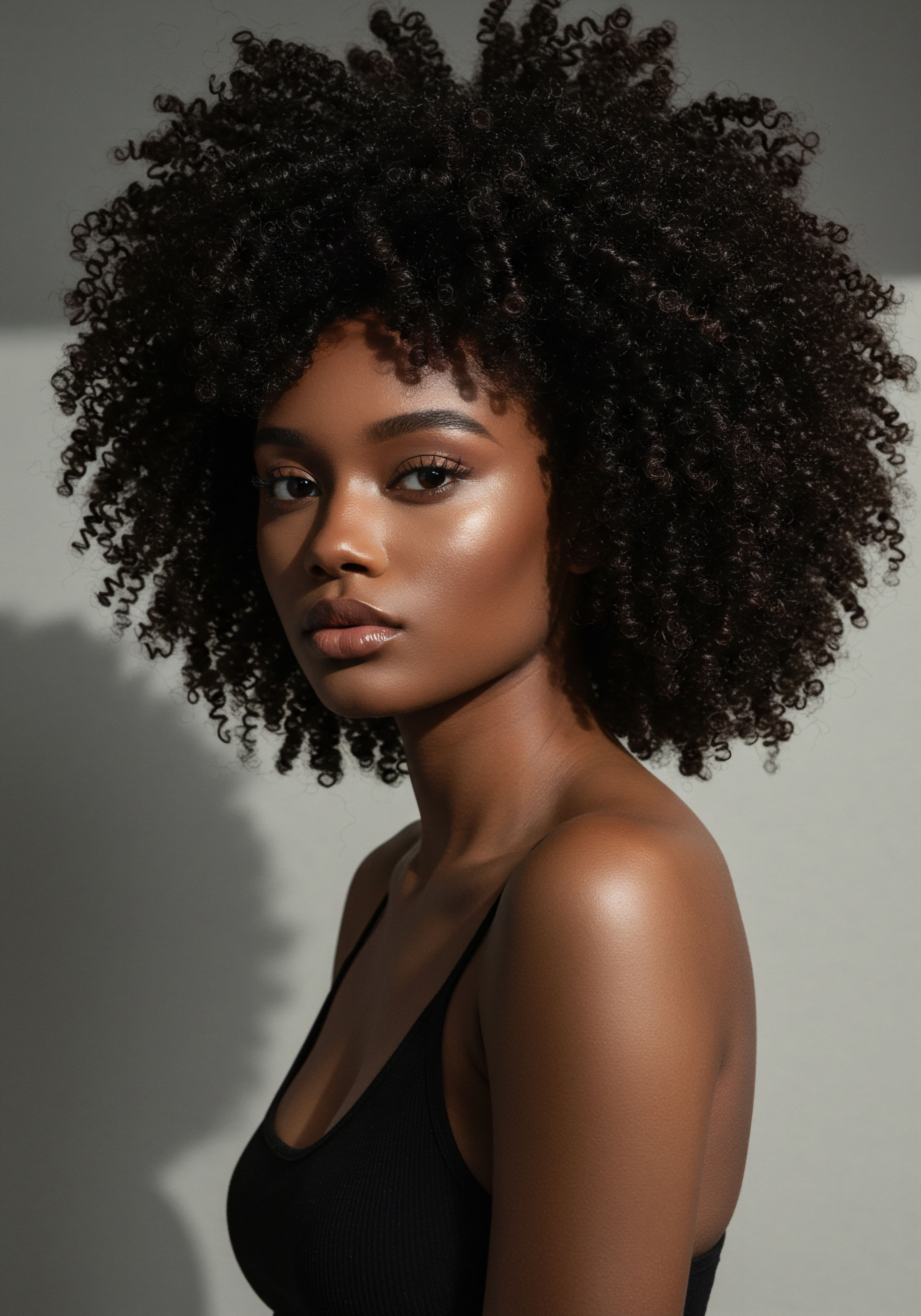
Roots
The very ground from which our strands ascend, the scalp, often whispers secrets we are only beginning to truly hear. For generations, across continents and cultures, oils have held a revered place in the tending of textured hair. We reach for them, guided by ancestral wisdom or the quiet promise of a sheen, a softness. Yet, beneath the visible gleam, a silent conversation unfolds between the oil’s very nature and the delicate landscape of our scalp.
The fluidity, the weight, the way an oil flows or clings—these are not mere trivialities. They speak directly to the thriving or struggling of the skin that cradles our hair, dictating how deeply nourishment can descend, or conversely, how easily a burden might settle. This exploration delves into the foundational connection between an oil’s physical attributes and the vibrant ecosystem of our scalp, a relationship often overlooked in the pursuit of superficial shine.

The Scalp’s Delicate Balance
The scalp, a specialized expanse of skin, serves as the ultimate foundation for hair growth. Its surface is home to a complex interplay of microorganisms, known as the Scalp Microbiome, and a protective layer of sebum, the skin’s natural oil. This intricate balance is vital for maintaining a healthy barrier against environmental aggressors and for fostering an optimal environment for hair follicles. When this equilibrium is disturbed, a cascade of issues can arise, ranging from irritation and dryness to more persistent conditions like dandruff or folliculitis.
Understanding the scalp’s needs means acknowledging its distinct properties. Unlike the skin on other parts of the body, the scalp boasts a higher density of sebaceous glands, producing more sebum. This natural oil, while protective, can become problematic if its flow is hindered or if it mixes with external substances that disrupt its composition. The goal of any scalp application, therefore, is to work in concert with this natural system, rather than against it.

Oil’s Physical Properties and Initial Interaction
An oil’s consistency, often described as its viscosity, directly influences its initial interaction with the scalp. A Lighter Oil, possessing lower viscosity, tends to spread more readily and absorb with greater ease into the stratum corneum, the outermost layer of the skin. Consider the swift dispersion of jojoba or argan oil, which mimic the scalp’s natural sebum, allowing for quick penetration without leaving a heavy residue. These oils can deliver their beneficial compounds without overwhelming the scalp’s natural processes.
Conversely, Heavier Oils, characterized by higher viscosity, tend to sit on the surface, forming a more occlusive layer. Castor oil, with its notable thickness, serves as a prime example. While this occlusive quality can be advantageous for sealing in moisture on hair strands, its impact on the scalp requires a more nuanced consideration. The immediate feeling upon application—whether light and breathable or dense and enveloping—is the first signal of how an oil’s consistency will behave.

Does Oil Consistency Affect Scalp Barrier Function?
The skin barrier is a remarkable structure, composed of lipids and proteins, that acts as a gatekeeper, preventing excessive water loss and blocking the entry of harmful substances. The choice of oil, particularly its consistency, plays a role in supporting or challenging this vital function. Oils that are too heavy or applied in excess can create an overly occlusive layer, potentially disrupting the natural exchange of gases and moisture. This can lead to a phenomenon known as Occlusion Dermatitis, where the skin becomes irritated due to blocked pores and an altered microenvironment.
A study published in the International Journal of Cosmetic Science examined the effects of different lipid mixtures on skin barrier function, noting that certain fatty acid compositions, often found in lighter, less occlusive oils, were more readily integrated into the skin’s lipid matrix, thereby supporting barrier integrity. This suggests that oils with a consistency that allows for more natural absorption and less surface accumulation are generally more conducive to a healthy scalp barrier, allowing it to breathe and function optimally.
The physical fluidity of an oil shapes its immediate connection with the scalp, dictating its spread and initial interaction with the skin’s protective layers.
Understanding these foundational principles of oil consistency and scalp interaction lays the groundwork for more advanced explorations into ritual and relay, revealing how traditional practices and modern science converge to support scalp vitality.

Ritual
The rhythmic application of oils to textured hair and scalp is more than a simple act of care; it is a ritual, a deliberate sequence of movements and intentions passed down through generations. From the warming of oils in the palm to the gentle massage across the scalp, these practices speak to a deeper connection with our strands. But within this sacred ritual, the consistency of the chosen oil quietly shapes its efficacy.
The way an oil glides, the depth to which it seems to penetrate, and the sensation it leaves behind are all profoundly influenced by its viscosity, impacting how deeply our care can truly reach. This section uncovers how the physical characteristics of oils inform and transform our scalp care practices.

Application Techniques and Oil Viscosity
The success of any scalp oiling ritual is intimately tied to the application technique, which, in turn, should be adapted to the oil’s consistency. For Thin, Free-Flowing Oils such as grapeseed or sweet almond, a dropper can allow for precise, targeted application directly to the scalp, minimizing saturation of the hair strands themselves. These oils are ideal for light massages, as they spread easily without requiring excessive friction, reducing the risk of irritation. Their quick absorption means they are less likely to leave a heavy, lingering residue, making them suitable for more frequent use or for individuals with finer textured hair who seek scalp nourishment without weighing down their styles.
Conversely, Thicker, More Viscous Oils like unrefined shea butter or specific types of castor oil demand a different approach. These are often best warmed slightly to reduce their density, allowing for easier distribution. Finger application, rather than a dropper, often proves more effective, allowing for direct contact and a more deliberate massage.
The heavier nature of these oils means they form a more substantial layer on the scalp, which can be beneficial for those experiencing extreme dryness or flakiness, providing a protective barrier. However, the quantity used becomes paramount; a little often goes a long way to avoid product buildup.

Scalp Massage and Follicular Health
The act of scalp massage, a cornerstone of many hair care rituals, is significantly influenced by the oil’s consistency. A lighter oil provides a smooth glide, allowing for gentle, stimulating movements that encourage blood circulation to the hair follicles. This increased circulation can deliver vital nutrients and oxygen, supporting robust hair growth. When an oil is too heavy or sticky, the massage can become cumbersome, potentially leading to tugging on the hair or excessive friction on the scalp, which can be counterproductive and cause irritation.
The consistency also affects how well the oil can reach the follicular openings. A Very Thick Oil might struggle to penetrate the follicular ostia, potentially sitting on the surface and contributing to occlusion, particularly in individuals prone to buildup or those with a higher density of sebaceous glands. A medium-consistency oil, like olive or coconut oil, often strikes a balance, offering enough slip for a thorough massage while still being able to deliver beneficial compounds closer to the root.

Balancing Moisture and Sebum Production
One of the primary goals of scalp oiling is to maintain optimal moisture levels without disrupting the scalp’s natural sebum production. The consistency of the oil plays a critical role in achieving this delicate equilibrium.
- Lightweight Oils ❉ These oils, such as argan or jojoba, are often chosen for their non-comedogenic properties, meaning they are less likely to clog pores. They supplement the scalp’s natural moisture without inhibiting sebum flow, making them ideal for daily or every-other-day application. They allow the scalp to breathe and regulate its own oil production.
- Medium-Weight Oils ❉ Oils like avocado or olive oil provide a richer layer of moisture. They can be beneficial for scalps that tend towards dryness, offering more substantial hydration without being overly occlusive. These are often suitable for weekly or bi-weekly treatments.
- Heavy Oils ❉ Examples include castor oil or some types of shea butter. While excellent for sealing moisture onto hair strands, their use on the scalp requires careful consideration. Their density can create a more significant barrier, which, if not properly cleansed, could potentially signal to the sebaceous glands that sufficient oil is present, leading to a reduction in natural sebum production over time, or conversely, cause a buildup that irritates the scalp.
The tactile nature of an oil, its viscosity, shapes the efficacy of application techniques and the profound impact of scalp massage.
The ritual of oiling, when informed by an understanding of oil consistency, transforms from a mere habit into a precise act of intentional care, guiding the scalp towards a state of enduring health.

Relay
Beyond the immediate touch and visible effects, the interaction between oil consistency and scalp health transmits a more complex series of signals, a ‘relay’ of biological and ecological responses that shape the very future of our scalp’s vitality. This deeper examination moves beyond simple application to consider the intricate cellular communications, the microbial dynamics, and the long-term physiological shifts influenced by the type of oil we choose. The subtlety of an oil’s texture can, over time, rewrite the story of our scalp’s resilience and comfort. This section dissects the sophisticated interplay at the microscopic level, grounding our understanding in scientific observation and traditional wisdom.

Oil Viscosity and Follicular Occlusion
One of the most critical aspects of oil consistency, particularly for textured hair, is its propensity for Follicular Occlusion. The hair follicle is a delicate structure, and its opening (the ostium) must remain clear for healthy hair growth and proper sebum secretion. Oils with a very high viscosity, when applied liberally or not thoroughly cleansed, can physically block these openings. This blockage can lead to several undesirable outcomes.
An occluded follicle can become an anaerobic environment, meaning it lacks oxygen. This altered environment can favor the proliferation of certain anaerobic bacteria, such as Cutibacterium acnes (formerly Propionibacterium acnes), which are naturally present on the skin but can contribute to inflammation and folliculitis when conditions are favorable. Furthermore, blocked follicles can trap sebum and dead skin cells, leading to the formation of microcomedones, which are the precursors to scalp blemishes and irritation.
Consider a study published in the Journal of Clinical and Aesthetic Dermatology that highlighted how occlusive cosmetic products can contribute to follicular irritation and acneiform eruptions, a principle directly transferable to scalp health. While this study focused on facial skin, the underlying mechanism of follicular blockage and subsequent inflammatory response is highly relevant to understanding the impact of overly heavy oils on the scalp, particularly in individuals with a predisposition to scalp sensitivity or inflammatory conditions. The viscosity of an oil, therefore, acts as a silent messenger, either signaling openness and breathability to the follicles or, conversely, communicating a state of potential congestion.

Microbiome Shifts and Oil Composition
The scalp’s microbiome is a vibrant community of bacteria, fungi, and viruses that coexist in a delicate balance, contributing to skin immunity and overall health. The introduction of external oils, especially those with varying consistencies and fatty acid profiles, can subtly influence this microbial ecosystem.
| Oil Consistency Lightweight (e.g. Jojoba, Argan) |
| Typical Fatty Acid Profile Mimics sebum; rich in oleic acid, linoleic acid |
| Potential Microbiome Influence Generally supports existing microbiome, less likely to disrupt balance due to good absorption and low occlusivity. |
| Oil Consistency Medium-weight (e.g. Olive, Avocado) |
| Typical Fatty Acid Profile Higher in oleic acid, some saturated fats |
| Potential Microbiome Influence Can provide nutrients for certain beneficial microbes; moderate occlusivity requires careful cleansing to prevent overgrowth. |
| Oil Consistency Heavy (e.g. Castor, Shea Butter) |
| Typical Fatty Acid Profile Rich in ricinoleic acid (castor), stearic/oleic (shea) |
| Potential Microbiome Influence High occlusivity can create anaerobic conditions, potentially favoring opportunistic pathogens if not regularly removed. |
| Oil Consistency The molecular structure and density of an oil influence its interaction with the scalp's microbial community. |
For instance, some oils, particularly those high in saturated fatty acids, can serve as a food source for certain yeast species like Malassezia globosa, which are implicated in dandruff and seborrheic dermatitis. While these yeasts are naturally present, an oversupply of certain lipids can lead to their overgrowth. The consistency of the oil dictates how readily these lipids are available to the microbes and how effectively the oil can be cleansed from the scalp. A thick, persistent oil might linger, providing a prolonged feeding ground, whereas a lighter oil is more easily removed, preventing excessive microbial feasting.
An oil’s density transmits silent signals to the scalp’s cellular and microbial inhabitants, shaping the very environment for follicular vitality.
Conversely, oils with a higher proportion of linoleic acid (an essential fatty acid) can support a healthy skin barrier, which in turn helps to maintain a balanced microbiome. The ability of an oil to be absorbed, which is a function of its consistency, dictates how effectively these beneficial fatty acids can be delivered to the deeper layers of the epidermis and how much remains on the surface to influence microbial populations.

Long-Term Scalp Health Implications
The cumulative effect of consistently using oils of a particular consistency can manifest in long-term changes to scalp health.
- Chronic Occlusion ❉ Persistent use of overly heavy or poorly cleansed oils can lead to chronic follicular occlusion. This can result in sustained inflammation, a weakened scalp barrier, and even contribute to conditions like traction folliculitis if combined with tight styling, as the compromised skin is more susceptible to external stressors.
- Altered Sebum Regulation ❉ While the scalp produces its own sebum, consistently applying a heavy, occlusive oil might, over time, send signals that the scalp is sufficiently lubricated. This could theoretically lead to a downregulation of natural sebum production, making the scalp more reliant on external applications and potentially drier when oils are not applied. Conversely, lighter, breathable oils allow the sebaceous glands to continue their natural function without interference.
- Product Buildup and Residue ❉ The consistency of an oil directly impacts the ease with which it can be removed during cleansing. Thicker oils often require stronger cleansing agents or more rigorous washing, which can strip the scalp of its natural oils and disrupt the microbiome. This cycle of heavy oil application followed by harsh cleansing can perpetuate dryness and irritation. Lighter oils, being easier to rinse, allow for gentler cleansing routines that preserve the scalp’s natural protective mechanisms.
The choices we make regarding oil consistency, therefore, are not merely about immediate aesthetic outcomes but about a sustained dialogue with our scalp’s biological intelligence, a relay of information that shapes its health for years to come.

Reflection
Our journey through the delicate interplay of oil consistency and scalp health reveals a landscape far richer than simple lubrication. We have seen how the physical fluidity of an oil, its very weight and flow, initiates a cascade of interactions—from the immediate sensation upon application to the profound shifts within the scalp’s microscopic world. The ancient wisdom of anointing, the modern understanding of microbial balance, and the nuanced science of follicular function all converge, illustrating that true scalp vitality arises from a mindful connection with the substances we choose. Each drop, each spread, contributes to a living narrative of care, a continuous conversation between tradition, science, and the vibrant life beneath our strands.

References
- 1. Rawlings, A.V. & Harding, C.R. (2004). Stratum Corneum Desquamation and the Role of Lipids. In The Skin Barrier (pp. 139-161). CRC Press.
- 2. Kligman, A.M. & Leyden, J.J. (1984). Acne ❉ A Review of the Current Literature. Journal of Clinical and Aesthetic Dermatology, 1(1), 1-10.
- 3. Draelos, Z. D. (2010). Cosmetic Dermatology ❉ Products and Procedures. Wiley-Blackwell.
- 4. Sperling, L. C. (2001). An Atlas of Hair Pathology with Clinical Correlations. Parthenon Publishing Group.
- 5. Burgdorf, W. H. C. Plewig, G. Wolff, H. H. & Landthaler, M. (2008). Braun-Falco’s Dermatology. Springer.
- 6. Zouboulis, C. C. & Picardo, M. (2016). Sebaceous Glands ❉ Biology, Pathobiology and Clinical Implications. CRC Press.
- 7. Chen, M. (2018). Hair and Scalp Diseases ❉ Medical and Surgical Approaches. Springer.